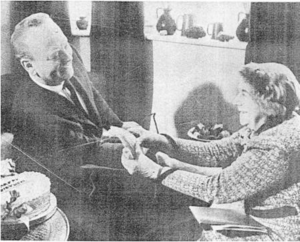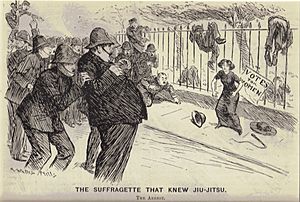Edith Garrud facts for kids
Quick facts for kids
Edith Margaret Garrud
|
|
|---|---|

Garrud demonstrating jujutsu on her husband dressed as a police officer in The Sketch
|
|
| Born |
Edith Margaret Williams
1872 |
| Died | 1971 (aged 99) |
| Nationality | British |
| Occupation | Martial arts instructor Playwright |
| Spouse(s) | William Garrud |
Edith Margaret Garrud (born Williams; 1872–1971) was a British martial artist and writer. She was also a suffragist, meaning she supported women's right to vote. Edith Garrud was the first British woman to teach jujutsu. She was also one of the first female martial arts teachers in the Western world.
Edith and her husband, William, learned jujutsu in 1899. They trained under Sadakazu Uyenishi. Later, Edith opened her own training school, called a dojo, in London. She joined the Women's Freedom League in 1906. There, she started a self-defence club. To show how jujutsu could help women, Edith wrote stories for magazines. She sometimes turned these stories into plays.
Garrud is famous for training the Bodyguard unit of the Women's Social and Political Union (WSPU). She taught them jujutsu self-defence. This helped protect their leaders from arrest and public violence. Edith Garrud helped create the image of the strong suffragette. These women were trained in hand-to-hand combat. They became a symbol of the fight for women's voting rights.
Contents
Early Life and Martial Arts Training
Edith Margaret Williams was born in 1872 in Bath, Somerset. She grew up in Wales. Later, she moved to England for her education. She trained to be a physical culture instructor for girls. In 1892, she met William Garrud. He was also an instructor, specializing in boxing and wrestling.
They married the next year and moved to London. William worked as a physical culture trainer for universities.
Discovering Jujutsu
In 1899, the Garruds saw a demonstration of jujutsu. It was given by Edward William Barton-Wright. He had studied jujutsu in Japan. Barton-Wright promoted jujutsu through shows and tournaments. He also started The Bartitsu School of Arms and Physical Culture. This was the first Japanese martial arts school in Europe.
The Garruds trained there under Yukio Tani and Sadakazu Uyenishi. These were experienced martial artists from Japan. After the Bartitsu school closed in 1902, the Garruds kept training with Uyenishi. They went to his school, The School of Japanese Self-Defence.
Becoming Instructors
In late 1908, Uyenishi returned to Japan. The Garruds took over his dojo. Edith taught women and children. William taught the men. A year later, Edith opened her own dojo. It was called The School of Ju-jutsu. Edith became the first British woman to teach jujutsu. She was also one of the first female martial arts instructors in the Western world.
Supporting Women's Rights
Edith Garrud supported women's suffrage. This was the movement for women to get the right to vote. In 1906, she joined the Women's Freedom League (WFL). To show how jujutsu could help women, the Garruds performed in public.
Public Demonstrations and Plays
During their shows, William would dress as a police officer. Edith would play a suffragette. He would try to arrest her, but she would use jujutsu to stop him. In 1907, Edith was in a short film. It was called The Lady Athlete; or, Jiu-Jitsu Downs the Footpads.
In 1908, she became the head of the WFL's athletics group. In May 1909, Edith performed at a "Woman's Exhibition." She explained jujutsu and invited people to test her skills. A police officer volunteered. Edith famously used a shoulder throw on him.
Training the Suffragettes
Suffragettes often faced violence during their campaigns. Emmeline Pankhurst, a WSPU leader, asked Garrud to train their members. Garrud started a special Self-Defence Club. It was only for WSPU members. The club met twice a week at her dojo.
A journal called Health and Strength wrote about her classes. They used the headline "Ju-jutsuffragettes: New Terror of the Police." Garrud wanted to make it clear. Her training was for self-defence, not to attack police. She wrote that police were often friends to suffragettes.
In 1910, Garrud wrote an essay for Votes for Women. She explained how martial arts could empower women:
Jujutsu is a Japanese art of self-defence. It is stronger than just brute force. So, it is not only a good skill, but a necessary protection for women. Women need to defend themselves throughout life. Physical strength seems to be the only area where women have not shown they are equal to men. While we wait for that equality to happen, we can use science, or ju-jitsu.
In July 1910, Health and Strength published a story by Garrud. It was called Damsel v. Desperado. It was about a small lady who used jujutsu to fight off two attackers. Punch magazine also published a cartoon about her. It showed a tiny lady using jujutsu on terrified police officers.
In 1911, Garrud choreographed a play. It was called Ju-Jutsu as a Husband-Tamer. It showed a wife using jujutsu to control her drunken husband. This showed how training could help women against violence at home. In June 1911, Edith led a procession for the WFL. Due to high demand, Garrud moved her club to the Palladium Academy.
Training the WSPU's Bodyguard
In 1913, the government passed the Cat and Mouse Act. This law allowed suffragette leaders on hunger strikes to be released from jail. They would recover at home, then be re-arrested. The WSPU created a special group to protect their leader, Emmeline Pankhurst. This group was called "the Bodyguard." It had thirty women members.
Newspapers called them the "Jiujitsuffragettes" and "Amazons." Garrud became their trainer. She taught them jujutsu and how to use Indian clubs for defence. They trained in secret places to avoid the police.
Famous Encounters
The Bodyguard fought many public battles with police. They were trying to arrest Pankhurst. Two famous events were the "Battle of Glasgow" in 1914 and the "Raid on Buckingham Palace" in 1914.
They also used clever tactics to escape and rescue people. They used disguises and decoys to confuse the police. A Bodyguard member, Katherine "Kitty" Marshall, wrote about these events. Journalists created the word "suffrajitsu." It combined "suffragette" and "jujitsu." It described their self-defence and clever tactics.
The Bodyguard stopped their work when the First World War began. Pankhurst decided to support the British government. When the war ended in 1918, women over thirty got the right to vote. All women got the vote ten years later.
Later Life and Legacy

Edith and William Garrud continued teaching self-defence and jujutsu. They sold their school in 1925. They had a son and a daughter. William Garrud passed away in 1960.
In 1965, on her 94th birthday, Edith Garrud was featured in Woman magazine. She showed some of her joint-locking techniques to a journalist. She died in 1971 at the age of 99.
Edith Garrud's classes helped women think differently about their abilities. They showed that women were not always vulnerable. Her work helped make martial arts a part of the culture. Her story has become almost like a legend. People talk about a secret group of female martial arts fighters.
Diana Looser, a scholar, wrote about Edith Garrud in 2011. She said that Garrud understood the power of jujutsu. By using jujutsu, Garrud challenged ideas about gender. She also changed how people saw Japanese martial arts. Garrud's use of martial arts helped bring about social change.
Images for kids
See also
 In Spanish: Edith Garrud para niños
In Spanish: Edith Garrud para niños



